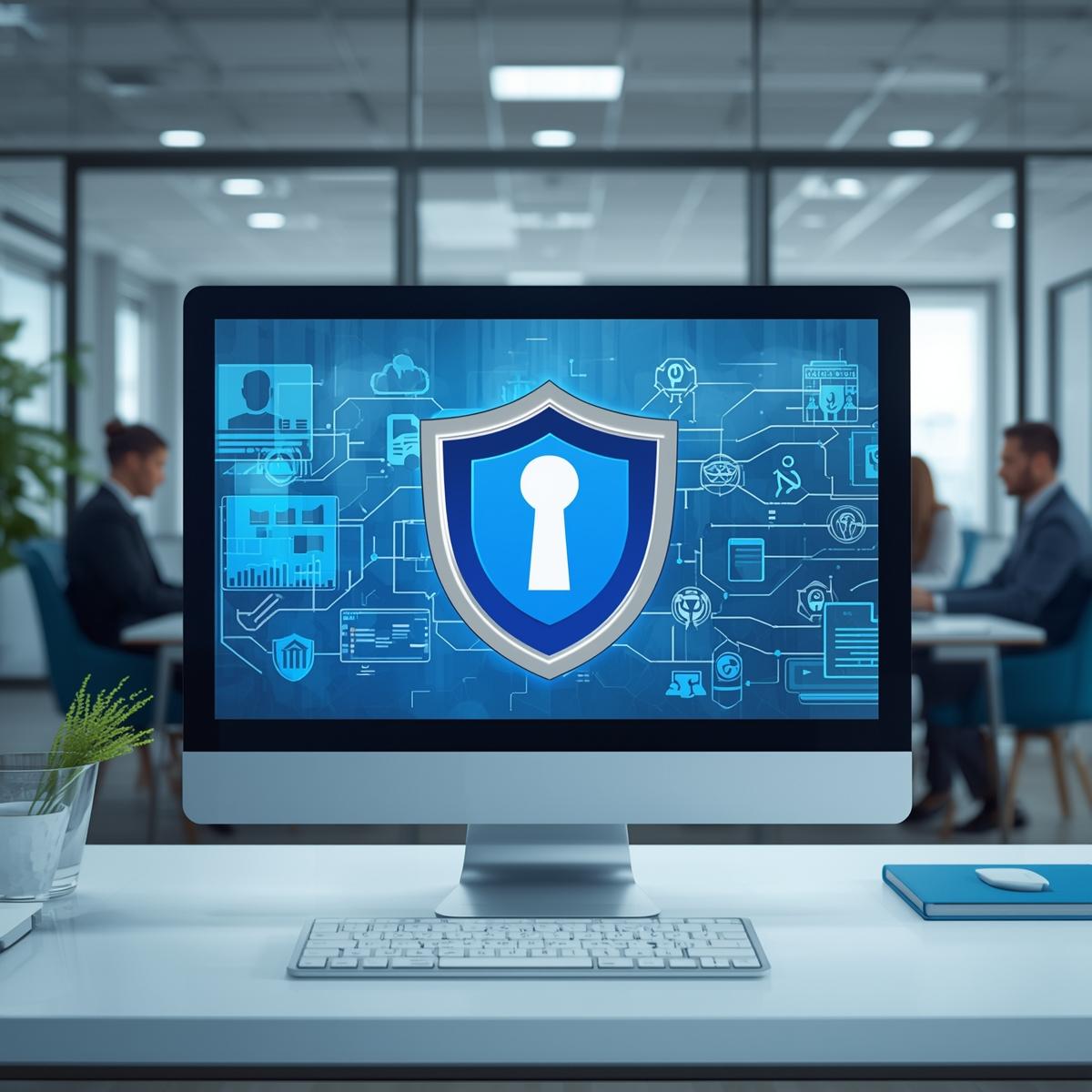
IT Solutions and Our Values
A few words on what matters to us and the values that dictate our IT solutions services.
In today’s digital era, small businesses face an unprecedented barrage of cyber threats, many of which are orchestrated by hackers exploiting system vulnerabilities. Statistics reveal that in 2024, a staggering 94% of small and medium-sized businesses experienced at least one cyber attack, with nearly half of all breaches affecting companies with fewer than 1,000 employees.
AI Audio with summary:

In today’s digital era, small businesses face an unprecedented barrage of cyber threats, many of which are orchestrated by hackers exploiting system vulnerabilities. Statistics reveal that in 2024, a staggering 94% of small and medium-sized businesses experienced at least one cyber attack, with nearly half of all breaches affecting companies with fewer than 1,000 employees. Despite this alarming reality, many small business owners still believe they are too small to be targeted or that robust IT security measures are beyond their budget. The truth is, they can afford protection—and they need it more than ever.
The solution lies in implementing a comprehensive, multi-layered defense strategy known as the 5 tier protection IT environment. This approach integrates five critical security components: email spam filtering, web content filtering, antivirus protection, endpoint detection and response (EDR), and backup and disaster recovery solutions. Together, these layers form a resilient shield that safeguards your business from a wide range of threats, including attacks on your networks, while minimizing damage if a breach occurs. It is essential to choose a reputable vendor for integrated security solutions to ensure your business receives the best possible protection.
Understanding why small businesses are so vulnerable is crucial before diving into layered protection. In 2024, 61% of small and medium-sized businesses were targeted by cyber attacks, yet many lack dedicated IT security staff or comprehensive security strategies. Businesses must determine their risk exposure and the appropriate security measures to protect themselves. The threat landscape is both vast and sophisticated. Phishing and credential theft fuel approximately 73% of breaches, malware accounts for 18%, and ransomware attacks on companies with fewer than 1,000 employees constitute 82% of all ransomware incidents.
This vulnerability has dire consequences: 60% of small businesses that suffer a cyber attack shut down within six months. The financial impact is equally severe, with the average data breach costing £3.28 million globally. For small businesses, costs range between £89,000 and £920,000, making cybersecurity not just an IT concern but a critical business survival issue. Investing in security can help save money in the long run by preventing costly breaches and protecting valuable assets.

Email remains the primary vector through which cybercriminals infiltrate businesses. Small businesses face the highest rate of targeted malicious emails, with one in every 323 emails being malicious. This makes email spam filtering an essential first line of defence in any 5 tier protection IT environment.
A robust spam filter scrutinises both incoming and outgoing emails, detecting and blocking spam, viruses, malware, and phishing attempts. These filters analyse sender addresses and IP addresses to identify illegitimate sources and block spam. Employing sophisticated technologies such as machine learning, sandboxing, and real-time threat analysis, these filters identify suspicious messages before they reach employee inboxes, preventing unwanted emails from reaching the inbox. Major email providers integrate spam filtering as a core feature to protect users and improve their email experience. They effectively block emails from known and emerging threats while maintaining detailed logs for forensic analysis if needed. Spam filters help stop malware and virus infections from spreading within the organisation and protect users from malicious content.
The business case for spam filtering is compelling. Without it, organisations face heightened risks of phishing, malware, and ransomware attacks delivered through malicious emails, lost productivity due to spam overload, and potential compliance violations. Filters use sender information to identify and block spam. Bayesian filters learn from user actions, adapting to better filter future emails. Employees in small businesses are subjected to 350% more social engineering attacks than those in larger firms, making spam filtering not just helpful but indispensable.
While spam filters protect your inboxes, web content filtering safeguards your network by preventing employees from accessing malicious websites that could compromise your systems. Attackers often use deceptive emails and online ads to lure employees to compromised sites hosting malware or phishing scams.
Web content filters act as gatekeepers between your network and the internet, monitoring and restricting access to risky websites. By blocking domains that host malware, phishing scams, and other cyber threats, these filters reduce the risk of infection and data breaches. They also prevent employees from visiting inappropriate or time-wasting sites, improving productivity. Additionally, web content filtering can limit access to non-work-related or high-risk websites, helping organizations enforce acceptable use policies and maintain a secure browsing environment.
Using technologies like DNS filtering and domain-based restrictions, web content filtering limits threats before malicious content ever reaches your network. This proactive layer significantly reduces malware infections, prevents inadvertent downloads of infected files, and eases the remediation workload for IT teams. In today’s remote and hybrid work environments, consistent web filtering across all access points is vital.
Although sometimes viewed as a legacy solution, antivirus software remains a fundamental pillar of IT security. Antivirus programs continuously monitor systems for known malware signatures and suspicious behaviour, enabling swift detection and quarantine of threats. In addition to endpoints, antivirus solutions also monitor servers for threats, helping to protect critical infrastructure from malware and spam-related risks.
Traditional antivirus primarily relies on signature-based detection, making it highly effective against known viruses and malware variants. However, it is not sufficient alone to combat modern, sophisticated attacks. That’s why antivirus works best when paired with other layers, such as EDR solutions.
Antivirus software provides valuable protection against commodity malware, which still accounts for a significant portion of cyber attacks. By rapidly isolating infected files and preventing their execution, antivirus acts as a reliable safety net within the broader 5 tier protection IT environment.
Modern cyber threats demand more than passive detection, which is where endpoint detection and response (EDR) solutions come into play. EDR represents a major advancement in endpoint protection platforms, shifting from reactive to proactive security.
EDR systems continuously monitor endpoints and network activity, using advanced analytics and artificial intelligence to identify suspicious behaviour that might otherwise go unnoticed. They provide real-time visibility into devices, including desktops, laptops, mobile devices, and any connected device. Securing each device is crucial, as every device can serve as a potential entry point for cyber threats, making comprehensive device protection essential.
When a threat is detected, EDR can automatically or semi-automatically respond by isolating infected devices, preventing lateral movement across the network, and stopping ransomware or malware from spreading. This rapid response capability allows IT teams to quickly identify, contain, and remediate attacks—often within minutes.
By preventing attackers from moving freely within your infrastructure, EDR significantly enhances your organisation’s ability to manage and mitigate cyber threats.
No security system is infallible, which makes a reliable backup and disaster recovery strategy the most critical tier in the 5-tier protection IT environment. Backups serve as your insurance policy against data loss caused by ransomware, system failures, or accidental deletion. It is essential to back up different data types, such as financial records and customer information, to ensure comprehensive protection and compliance with data protection policies.
Effective backup solutions employ immutable backups, which cannot be altered or deleted by attackers. These backups are stored securely both on-site and in the cloud, ensuring that if your systems are compromised, you can restore critical data and files without reinfecting your network.
Having the ability to roll back to previous file versions is invaluable, especially in the event of encryption attacks. Offline backups add an extra layer of protection, shielding your backups from network-based threats.
The financial benefits are clear: ransomware attacks cost organisations £600 million in 2024, with average payouts exceeding £2 million. However, businesses with robust backup systems experience dramatically reduced recovery costs. For example, a one-day outage for a small finance team might cost £5,000, but without proper backups, the cost could be exponentially higher.
A truly effective 5 tier protection IT environment relies on more than just individual security tools—it requires a centralized control and management system to orchestrate all your security layers seamlessly. By unifying email spam filtering, endpoint protection platforms, backup management, and network security under one roof, organizations can proactively protect their systems, employees, and customers from advanced threats and malicious hackers.
Centralized management empowers your business to set specific rules and security settings that automatically block emails from known spammers, filter out unwanted messages, and prevent spam emails from ever reaching employee inboxes. Leveraging machine learning, these systems can identify suspicious behavior and adapt to new attack methods, ensuring that both legitimate emails and critical business messages are delivered safely while malicious content is stopped in its tracks.
With a central control system, you can manage and monitor all endpoints—including desktops, laptops, and mobile devices—across your network. This unified approach allows you to quickly identify and respond to threats, such as phishing attacks or viruses, that target your email domain or attempt to access sensitive data. Automated responses can isolate compromised devices, block malicious links and files, and prevent malware from spreading, all while maintaining business continuity.
EDR solutions, such as Microsoft Defender for Endpoint, play a pivotal role in this ecosystem. These advanced tools provide real-time endpoint detection, automated remediation, and forensic analysis, enabling your security team to investigate incidents and respond to sophisticated attacks with speed and precision. By integrating EDR solutions with other security services, you create a robust defense that adapts to evolving threats and keeps your business traffic secure.
Rule-based filters are another essential component of central management. These filters can be configured to block specific phrases, suspicious domains, or unwanted emails, and are regularly updated to stay ahead of new spam tactics. By combining EDR solutions with rule-based spam filtering, your organization can effectively manage unwanted messages, protect inboxes, and ensure that only safe, relevant communications reach your team.
Central control also allows you to set internet access limits, manage network filters, and block access to malicious websites or files—helping to prevent attacks like denial of service (DoS) that can disrupt operations. Managing backups, services, and infrastructure from a single dashboard ensures that your data remains protected and recoverable, even in the event of a major attack.
Ultimately, central control and management are critical for orchestrating your security layers, enabling you to protect your data, systems, and customers from advanced threats. By implementing specific rules, leveraging machine learning, and integrating EDR solutions and rule-based filters, your organization can stay ahead of hackers, manage security efficiently, and build a resilient IT environment that supports business growth and customer trust.
The true strength of the 5-tier protection IT environment lies in the synergy of its components. This defence-in-depth strategy ensures that if one layer is breached, others remain to protect your business. Instead of relying on a single security measure, you deploy multiple, complementary layers that cover various attack vectors.
Implementing the Principle of Least Privilege further strengthens your defences by limiting user access to only what is necessary, reducing the damage potential if credentials are compromised. Combined with multi-factor authentication and endpoint protection, this strategy creates a formidable barrier against cyberattacks.
For small businesses, investing in a comprehensive 5-tier protection system is an investment in continuity and resilience. Preventative security measures are always more cost-effective than recovery efforts after an attack.
When selecting solutions, prioritise vendors that offer integrated platforms combining all five layers rather than disparate point products. This integration ensures the consistent application of security policies and simplifies management. Make sure your protection extends to all communication channels, including phone systems, as spam and threats can be delivered via email, messaging, and phone calls.
Begin by assessing your current security posture, then prioritise implementation based on your specific threat landscape and risk profile. Aligning with frameworks like the NIST Cybersecurity Framework’s Tier 2 or 3 levels naturally supports the deployment of a 5 tier protection IT environment.
In today’s threat landscape, the question isn’t whether your business can afford to implement a comprehensive security system—it’s whether you can afford not to. With 94% of small businesses facing cyberattacks and 78% believing a breach could put them out of business, adopting a 5 tier protection IT environment is essential.
By combining email spam filtering to block malicious emails, web content filtering to prevent access to harmful sites, antivirus to catch known malware, EDR to detect advanced threats, and robust backup solutions to ensure rapid recovery, you create a business that is significantly harder to breach.
Invest in this multi-layered defense today, and you’ll secure your business’s tomorrow.
AI Audio with summary:

A few words on what matters to us and the values that dictate our IT solutions services.

Web filtering: it’s not just about blocking dodgy websites. Think of it as a digital gatekeeper that stops distractions and threats before they even reach your team.

Whether you’re managing a bustling startup or an established enterprise, hosted desktop support has emerged as a cornerstone of modern business continuity strategies.